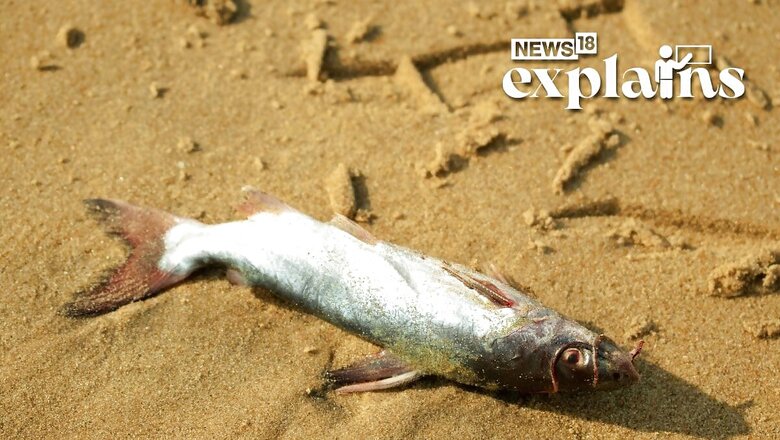
views
Authorities in Texas are requesting people to stay away from a beach following many dead fish that started washing up on the shore on Friday, according to a report by NBC News. The fish, predominantly Gulf menhaden, a common bait fish, were observed in large quantities on the shore. Video footage depicted thousands of fish carcasses floating on the surface of the water at Bryan Beach.
The officials at Quintana Beach County Park cautioned swimmers to refrain from visiting the coastline due to elevated levels of bacteria and the presence of sharp fins on the deceased fish.
In a Facebook statement, they advised, “Our recommendation is to avoid the beach entirely until this occurrence concludes. We strongly discourage anyone from entering the water.”
But What Killed the Fish?
According to the Smithsonian Mag, when the “Kills and Spills” team from Texas Parks & Wildlife examined the area, they discovered very little oxygen dissolved in the water.
According to a statement posted on the Quintana Beach County Park Facebook page, fish deaths like this are common during the summer when temperatures rise. Insufficient oxygen in the water is a natural occurrence and prevents fish from breathing properly.
Officials explained that the situation began with a combination of factors that reduced the oxygen levels near the shore. As the summer weather heats up, the shallow water near the beach becomes warmer. Higher temperatures result in the water holding less oxygen. If a school of fish was swimming in shallow water as the temperature surpassed 70 degrees Fahrenheit, they could face significant problems.
Additionally, the nearshore waters of the Gulf of Mexico in Brazoria County have been calm for the past three weeks, with minimal wave action. This means that very little oxygen has been entering the water through surface mixing, the report explained.
Furthermore, the region has experienced numerous overcast days recently. The presence of clouds blocks sunlight, leading to reduced photosynthesis by microscopic phytoplankton and macroalgae. As a result, they produce less oxygen. Meanwhile, the plants and animals in the water continue to consume the same amount of oxygen as usual, causing an overall decrease in oxygen levels.
The statement noted that before a mass fish death event occurs, fish can be observed attempting to obtain oxygen by gulping at the water’s surface in the early morning. Some fish may also be found lying on the bottom or at the water’s edge.
However, Bryan Frazier, the director of Brazoria County Parks Department, told the New York Times that oxygen levels should return to normal soon, as nature has a way of balancing things out.
Deeper Look at Fish Kills
Some fish deaths in the summer are caused by low levels of dissolved oxygen in the water, although not all. Fish, like other living organisms, require oxygen to survive, which they obtain from oxygen gas dissolved in the water. Therefore, having an aeration device, such as a bubbler, in an aquarium is important, according to a report by the USGS.
During the summer, warm water holds less dissolved oxygen compared to cold water. This makes it challenging for fish to acquire enough oxygen. Other organisms, including algae and bacteria, also consume oxygen. While algae produce oxygen through photosynthesis during the day, they and other organisms continue to respire and consume oxygen at night when photosynthesis stops, the report explains.
In warm summer nights, particularly during algal blooms, the concentration of dissolved oxygen can drop to levels insufficient for fish survival, leading to fish die-offs. These die-offs can occur naturally or be exacerbated by human activities that introduce nutrients like nitrogen and phosphorus into water systems. Nutrients can come from various sources such as fertilizers, vehicles, sewage, and manure. An excess of nutrients promotes algae growth and reduces the availability of dissolved oxygen. Other factors like poor flushing or circulation, dredging, or sudden rainfall after a dry period can also contribute to low dissolved oxygen levels.
Fish kills can also result from toxic compounds being released into a body of water. However, for this to occur, the toxic compound must be highly concentrated. In large water bodies like the Chesapeake Bay, a substantial amount of the toxic compound and its release site in close proximity to the affected fish would be necessary.
Clean Up Ops in Texas
The cleanup operations began on Friday and concluded on Sunday when the remaining fish remains, which had degraded to the extent of becoming shredded skeletons, were washed up on the shore, officials told NBC News.
Despite the completion of the cleanup, local authorities advised visitors to wait for a few days before visiting the beach.
Water samples collected from the Gulf Intracoastal Canal and the Brazos River, which flow into the coast, revealed extremely low levels of dissolved oxygen, as reported by local officials. Quintana Beach County Park officials stated that there was no indication of a chemical spill causing the event.


















Comments
0 comment